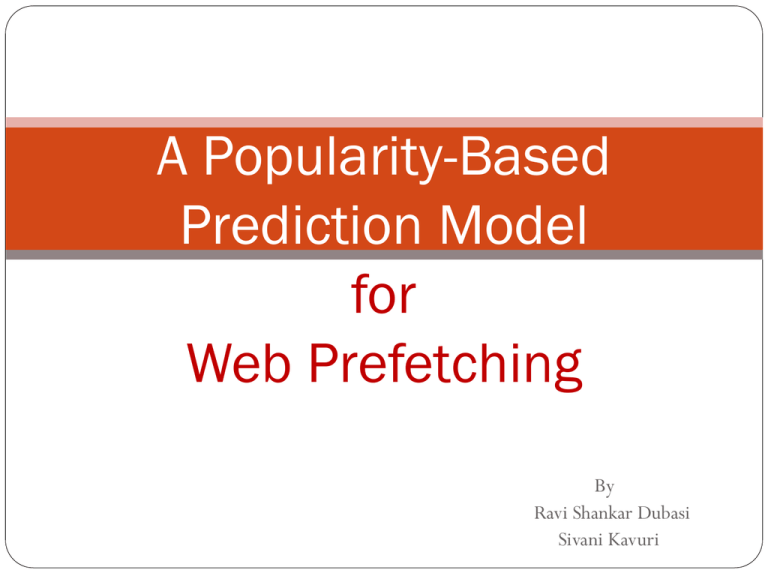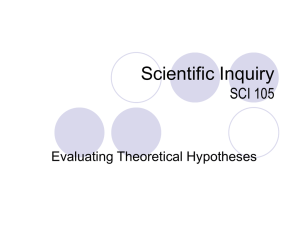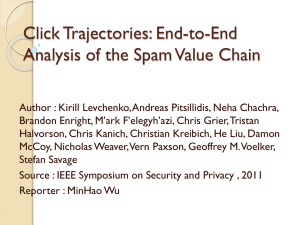Slides
advertisement

A Popularity-Based
Prediction Model
for
Web Prefetching
By
Ravi Shankar Dubasi
Sivani Kavuri
What is Web Latency?
What is Web Caching?
How does Web Caching help in reducing Web Latency?
What is Web Prefetching?
How does Web Prefetching help in reducing Web Latency?
Does Web Prefetching really decrease Web Latency!!!!
Combining Caching and Prefetching.
Performance Improvement.
Why Prediction Models?
What are Prediction Models?
How aggressive Prefetching is?
How aggressive Prefetching can be?
PPM (Prediction by Partial Match) Model
Slight variations to this model..
Model proposed by Xin Chen and Xiaodong Zhang.
POPULARITY BASED
PREDICTION MODEL
Log files
Access Session:
URL
ENTER
EXIT
3 Major Regularities:
Regularity 1: Majority Clients start their access session from popular URLs of a
server. However, majority of URLs in a server are not popular files.
Regularity 2: Majority Long access sessions are headed by popular URLs.
Regularity 3: The accessing paths in majority access sessions start from popular
URLs, move to less popular URLs, and exit from the least URLs. The accessing paths
in minority access sessions start from less popular URLs, and remain in the same
type of URLs, and exit from the least popular URLs.
Popularity of URLs
How to determine popularity of URLs?
How do we grade the URLs?
How to determine Relative Popularity?
Grade 3 : 10<RP≤100%
Grade 2 : 1<RP≤10%
Grade 1 : 0.1%<RP≤1%
Grade 0 : RP≤0.1%
Distribution of Popularity Grades
To examine relationship between URL popularity and access
session
Divided each trace into 4 session groups
Regularity 1 is observed
Observations
Paying special attention to popular URLs which are only a small %
Is this advantageous????
Paying small attention to less popular URLs which can be large
What about this???
Popularity and session length
Day 79 traces
86% of access sessions started from popular URLs, moved to less
popular URLs and exited from the least popular URLs
Regularity 2 is observed
The average popularity grade decreases as the session length
increases.
Observations
Clients starting with less popular URLs tend to surf among URLs with the same
popularity.
3 Prediction Models
1.
Standard model
2.
LRS model (longest repeating sequence)
3.
Popularity-based model
(All models are evaluated here according to the 92 day evaluation period)
(All models use the Markov Tree representation)
Standard Model
Node 0 represents the root of the forest
When Client access URL the model builds a new tree with
root A
The Counter is set to 1
The counter is incremented every time that URL is accessed
in the session
The process continues till we complete all the sessions
Every path from root node to leaf node represents the URL
session for at least one client
STANDARD PPM
0
A/2
B/2
C/2
A’/2
B’/2
B/2
C/2
A’/1
B’/2
C’/2
C/2
A’/1
B’/1
C’/2
A’/1
B’/1
C’/1
C’/2
The Three Access
Sequences are:
{ABCA’B’C’}
B’/1
C’/1
C’/1
{ABC}
{A’B’C’}
Advantages and Disadvantages:
Easy to build (not complex)
Prediction accuracy improves
More Space required
( increases with increase in prediction order)
(determined by Entropy analysis and emperical studies)
Attempts for Space Optimization:
Tree no longer resembles the regular surfing patterns
Prediction accuracy low (short tree)
Small height increase rapidly increases storage requirements.
LRS Model
LRS Model keeps the longest repeating subsequences
stores only long branches with frequently accessed URLs
The server builds the tree the same way as in standard PPM
Scans each branch for non-repeating sequence
Identifies and eliminates the non-repeating sequence
The stored longest sequence is the frequently repeating
sequence
(at least one occurrence of one subsequence belongs to an
independent access sessions)
0
A/2
B/2
C/2
A’/2
B’/2
B/2
C/2
A’/1
B’/2
C’/2
C/2
A’/1
B’/1
C’/2
A’/1
B’/1
C’/1
C’/2
The Three Access
Sequences are:
{ABCA’B’C’}
B’/1
C’/1
C’/1
{ABC}
{A’B’C’}
Advantages and Disadvantages:
LRS PPM model offers a lower storage requirements and higher
prediction accuracy
It has low hit rates
( because tree keeps only a small number of frequently accessed branches
(popular) it ignores prefetching for less frequently accessed URLs
(unpopular) so overall prefetching rate can be low)
The Process is expensive
( To find the longest matching , the server must have all all previous URLs
of current session, thus the server must maintain sessions and update
them)
Popularity Based Prediction Model
It uses only the most popular URLs as root nodes
Each URL in a sequence is added only once to the tree unless the its
Popularity grade is higher than the root node
Maximum tree height is based on
Available memory space
Access session lengths
Space Optimization is done to the completed tree based on:
Relative access probability
Absolute Number of accesses
(RAP=Number of accesses to the URL/Number of accesses to the parent URL)
0
A’/2
A/2
B/2
C/2
A’/1
A’/1
B’/2
C’/2
The Three Access
Sequences are:
{ABCA’B’C’}
{ABC}
{A’B’C’}
Advantages and Disadvantages:
Space Optimization
(since less number of nodes)
High Prediction Accuracy
(since it includes access information)
For higher Thresholds --- HIT Ratio decreases
(since unpopular files domination increases)
OBSERVATIONS
The Standard PPM model without limiting branch height.
The LRS PPM model keeping the longest repeating subsequence.
Popularity-based PPM model with space optimization.
1) In Standard PPM model without limiting height of each branch,
Prediction accuracy is increased
2) In LRS PPM model keeping longest repeating sequence i.e removing
independent access sessions,
Space is saved
3) In Popularity-based PPM model space optimization considering relative
access probability,
Preserves Prediction accuracy
Integrating prediction model with prefetching and
caching
Cache memory is divided into 2 parts.
Prefect buffer
Cache memory
Prefetching manager
Cache manager
PREDICTION ENGINE
Constructs and updates prediction model
(based on requests issued)
Offers prediction independently to each client.
Integrated Web Caching and Prefetching Model
PREDICTION ALGORITHM
current_context [0] : root node of T;
for length j=1 to m
current_context [j]:=NULL;
for every event R in S
for length j= 0 to m {
if current_context[j] has child node C representing event R {
node C occurrence_count:=occurrence_count +1 ;
current_context[j+1]:= node C;
}
else {
construct child node C representing event R;
node C occurence_count:=1;
current_context[j+1]:=node C;
}
current_context[0]:= root node of T;
}
PREFETCHING ALGORITHM
LET S be the set of all objects currently in the prefetch buffer;
LET P=Ø;
//P is set of objects to be prefetched
LETTotalSize = 0;
// the total size of all objects in P
LET j = 0;
WHILE (j ≤ n) AND (TotalSize < SIZEOF (prefetch buffer))
IF (O(j) not in cache) AND (O(j) not in prefetch buffer) THEN
Put O(j) into P ;
LETTotalSize = TotalSize+SIZEOF(O(j));
j=j+1;
END IF
ENDWHILE
LET M=S.P;
Simulation Parameters
1.
Order of Prediction
2.
Confidence
3.
Previous requests
4.
Number of predictions
5.
Browsing session idle time
6.
Client cache size
7.
Client cache idle time
Performance Metrics
Usefulness of Predictions ( Hit ratio )
2. Accuracy of Predictions
3. Network traffic
4. Space Optimization
1.
( Model aims at maximizing first two metrics and minimizing last two
metrics)
Maximum size of prefetched files effect both hit ratios and network
traffic.
Large values »» more traffic »» high hit ratio
Hit Ratio
Ratio between no. of requests that hit the browser or cache
and the total no. of requests .
Latency Reduction
Average access latency time reduction per request.
Space
Required memory allocation measured by the no. of nodes
for building a PPM model in the web server for prefetching.
Traffic Increment
Ratio between the total no. of transferred bytes and the total
no. of useful bytes for the clients minus 1.
Hit ratio vs threshold
Traffic Increment Vs Threshold
Number of Nodes Vs Number of Clients
CONCLUSIONS
Effective web management approach.
Makes searching and prefetching highly objective and highly
efficient.
Web prefetching can have both high prediction accuracy and
a low space requirement.
FUTURE WORK
To make the model more flexible.
To find more elaborate ways of making predictions.
Filtering out the effect of backward references.
Extending
predictions.
prediction engine to accommodate more





